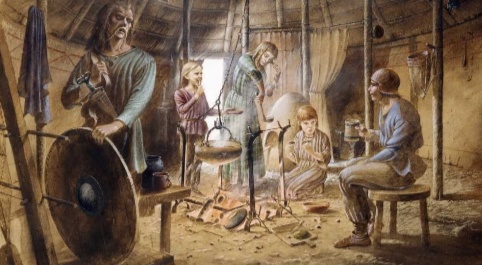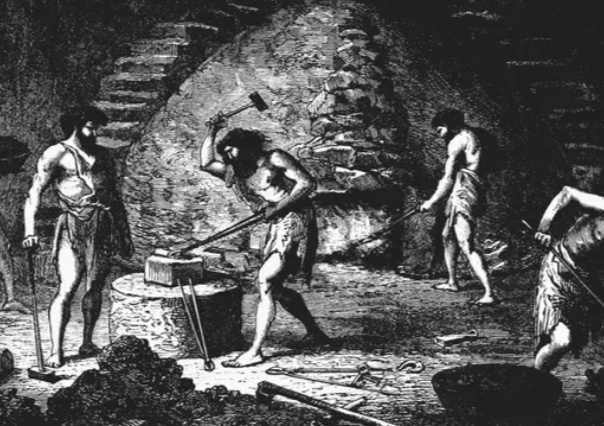The Iron Age was a period in human history that started between 1200 B.C. and 600 B.C., depending on the region, and followed the Stone Age and Bronze Age. During the Iron Age, people across much of Europe, Asia and parts of Africa began making tools and weapons from iron and steel. For some societies, including Ancient Greece, the start of the Iron Age was accompanied by a period of cultural decline.
Humans may have smelted iron sporadically throughout the Bronze Age, though they likely saw iron as an inferior metal. Iron tools and weapons weren’t as hard or durable as their bronze counterparts.
The use of iron became more widespread after people learned how to make steel, a much harder metal, by heating iron with carbon. The Hittites—who lived during the Bronze Age in what is now Turkey—may have been the first to make steel.”
The Persians established their empire at a time after humans had learned to make steel. Steel weapons were sharper and stronger than earlier bronze or stone weapons.
The ancient Persians also fought on horseback. They may have been the first civilization to develop an armored cavalry in which horses and riders were completely covered in steel armor.
The First Persian Empire, founded by Cyrus the Great around 550 B.C., became one of the largest empires in history, stretching from the Balkans of Eastern Europe to the Indus Valley in India.

Sources:
The Iron Age was a period in human history that started between 1200 B.C. and 600 B.C., depending on the region, and followed the Stone Age and Bronze Age. During the Iron Age, people across much of Europe, Asia and parts of Africa began making tools and weapons from iron and steel. For some societies, including Ancient Greece, the start of the Iron Age was accompanied by a period of cultural decline.
Humans may have smelted iron sporadically throughout the Bronze Age, though they likely saw iron as an inferior metal. Iron tools and weapons weren’t as hard or durable as their bronze counterparts.
The use of iron became more widespread after people learned how to make steel, a much harder metal, by heating iron with carbon. The Hittites—who lived during the Bronze Age in what is now Turkey—may have been the first to make steel.
When Was the Iron Age?
The Iron Age began around 1200 B.C. in the Mediterranean region and Near East with the collapse of several prominent Bronze Age civilizations, including the Mycenaean civilization in Greece and the Hittite Empire in Turkey. Ancient cities including Troy and Gaza were destroyed, trade routes were lost and literacy declined throughout the region.
The cause for the collapse of these Bronze Age kingdoms remains unclear. Archaeological evidence suggests a succession of severe droughts in the eastern Mediterranean region over a 150-year period from 1250 to 1100 B.C. likely figured prominently in the collapse. Earthquakes, famine, sociopolitical unrest and invasion by nomadic tribes may also have played a role.
Some experts believe that a disruption in trade routes may have caused shortages of the copper or tin used to make bronze around this time. Metal smiths, as a result, may have turned to iron as an alternative.
Many scholars place the end of the Iron Age in at around 550 B.C., when Herodotus, “The Father of History,” began writing “The Histories,” though the end date varies by region. In Scandinavia, it ended closer to A.D. 800 with the rise of the Vikings. In Western and Central Europe, the end of the Iron Age is typically identified as coinciding with the Roman conquest during the first century BC.
Greek Dark Ages
Greece had become a major hub of activity and culture on the Mediterranean during the late Bronze Age. The Mycenaean civilization was rich in material wealth from trade. Mycenaeans built large palaces and a society with strict class hierarchy.
But around 1200 B.C. Mycenaean Greece collapsed. Greece entered a period of turmoil sometimes called the Greek Dark Ages.
Archaeologists believe there may have been a period of famine in which Greece’s population dropped dramatically during this time. Major cities (with the exception of Athens) were abandoned. As urban societies splintered, people moved toward smaller, more pastoral groups focused on raising livestock.
Mycenaean Greece had been a literate society, but the Greeks of the early Iron Age left no written record, leading some scholars to believe they were illiterate. Few artifacts or ruins remain from the period, which lasted roughly 300 years.
By the late Iron Age, the Greek economy had recovered and Greece had entered its “classical” period. Classical Greece was an era of cultural achievements including the Parthenon, Greek drama and philosophers including Socrates.
The classical period also brought political reform and introduced the world to a new system of government known as demokratia, or “rule by the people.”
Persian Empire
During the Iron Age in the Near East, nomadic pastoralists who raised sheep, goats and cattle on the Iranian plateau began to develop a state that would become known as Persia.
source Editors of History. com.


